

15-Minute Beginner HIIT Workout (No Repeat)
HIIT workouts have been popular for years – but they aren’t always accessible to beginners, or friendly on the joints. This beginner HIIT workout is the perfect compromise; bringing all of the intensity without any running or jumping. I love that this full body routine is all standing, no repeats and requires no equipment.
When you think of HIIT exercises, you might think of high-intensity (and high-impact) movements like burpees, squat jumps, or jumping lunges.
HIIT (high intensity interval training) is known and loved for being particularly effective at burning the most amount of calories in a short amount of time. However, if you’re just getting started with HIIT, high-impact exercises may be too intense, and potentially cause joint pain or injury.
This beginner HIIT workout is a perfect example of a workout routine that’s high-intensity but low-impact.
We’ll rotate through a series of bodyweight exercises, alternating short bursts of high intensity work with minimal rest periods between moves. This keeps our heart rates high throughout the entire workout, burning more calories and making the workout more effective.
Beginner cardio workouts are a great way to establish a fitness routine at home, boost your mood and establish proper form before adding weights to your workouts.
Ready to add weight training to your workout program? I recommend trying this beginner dumbbell workout or this beginner kettlebell workout.

Beginner HIIT Workout (Full Body Sweat)
Kick your fitness routine into high-gear with this quick HIIT workout.
This workout is high-intensity but low-impact, making it a great option for anyone who wants to burn calories and improve fitness levels at home without putting pressure on the joints.
I recommend incorporating HIIT workouts like this one to your beginner workout plan 1-2 times a week.
Workout Equipment:
No equipment, just your bodyweight.
Workout Instructions:
Follow along with the guided Beginner HIIT Workout on Youtube, led by certified personal trainer Lindsey Bomgren.
Your Workout Looks Like This:
- 7 Beginner HIIT Exercises (10 exercises total when repeating on both sides of the body)
- Timed Intervals (40 seconds work, 20 seconds rest)
- Perform Each Exercise x1 Set (no repeats)

Prefer to Watch On YouTube?
Workout Outline
- Squat and Reach with Calf Raise
- Standing Crunch and Pulse Squat
- High Knees and Lateral Squat Shuffles
- Ski Runs and Lateral Lunge (Right)
- Reverse Lunge Knee Slam (Right)
- Jabs and Knee Strikes
- Ski Runs and Lateral Lunge (Left)
- Reverse Lunge Knee Slam (Left)
- Oblique Crunch and Cross Body Punch (Right)
- Oblique Crunch and Cross Body Punch (Left)
Beginner HIIT Exercises
Squat and Reach with Calf Raise
Targets: Quads, glutes, hamstrings, calves, shoulders and core.

How To Do Squat Reaches with Calf Raises
- Stand with your feet shoulder-width apart, knees slightly bent, and core engaged.
- Lower into a squat position, lowering your hips until they are parallel to your knees, both knees bent at 90 degree angles. Think about driving your knees out towards your outer three toes. Option to tap the ground outside your feet with your fingertips.
- Drive through your heels to stand tall, squeezing your glutes. Reach your arms overhead as you stand.
- As you stand, perform a calf raise by lifting your heels off the ground.
Standing Crunch and Pulse Squat
Targets: Quads, glutes, hamstrings, hip flexors, lower abs and obliques.
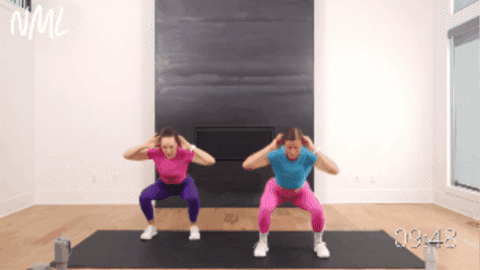
How To Do Standing Crunches and Squat Pulses
- Start standing in an athletic stance, feet hip-distance apart, shoulders stacked over hips. Place your fingertips behind your head, elbows out wide.
- Bend your knees, lowering your hips into a squat, 90 degree bends in both knees.
- Pulse up and down an inch, performing four squat pulses.
- Then, drive through your heels to stand tall.
- Drive your left knee up as you rotate your torso towards your left knee, aiming to bring right elbow to tap left knee. Return your left foot to the ground.
- Repeat on the other side, bringing right knee up in line with your hips as you rotate towards your right knee, bringing left elbow to tap right knee.
- Repeat, alternating four squat pulses with four standing crunches.
High Knees and Lateral Squat Shuffles
Targets: Legs, glutes, quads, hamstrings, hip abductors, hip flexors, calves and core.
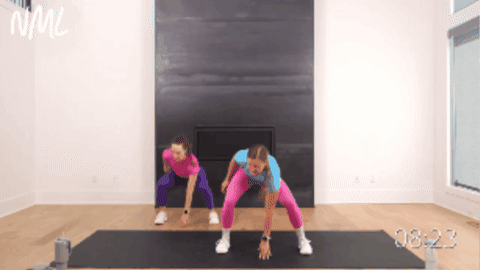
How To Do High Knees and Lateral Squat Shuffles
- Start standing, feet under hips, core engaged.
- Perform two high knees, driving first your left, then your right knee up towards your chest. Aim to get your knees in line with your hips.
- Then, take a step out to your left, bending your knees to lower your hips as you tap the ground between your legs with your right fingers.
- Leading with your left foot, perform a loaded shuffle, stepping or hopping both feet over to the right.
- Lower your hips, tapping the ground between your legs with your left fingers.
- Repeat, alternating four high knees with two lateral squat shuffles.
Ski Runs and Lateral Lunge
Targets: Calves, quads, hamstrings, glutes, outer glutes, inner thighs, abs and core.
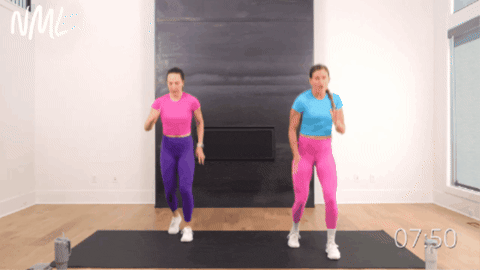
How To Do Ski Runs and Lateral Lunges
- Start by standing with your feet shoulder-width apart and your arms at your sides, spine straight and hips facing forward.
- Find a split stance position by stepping the right foot just in front of the left. Right heel should be in line with left toes. Feet are parallel; imagine you are standing on train tracks.
- Perform a small jump as you switch your stance, bringing the left foot forward as you send the right foot back. Land softly, then repeat, performing two ski runs. You should end with your right foot in front of left foot.
- Then, take a large step out towards your left, keeping your right foot in place. Sit your hips back, bending your left knee while keeping your right leg straight.
- Then, drive off your left foot to return to the starting position.
- Continue this pattern, alternating two ski runs with one lateral lunge.
Reverse Lunge Knee Slam
Targets: Legs, glutes, quads, hamstrings and core.

How To Do Reverse Lunge Knee Slams
- Stand with feet shoulder width apart, shoulders stacked over hips.
- Step your left leg back into a reverse lunge, keeping your right leg in place. Lower your hips until both knees reach a 90-degree angle, right thigh parallel to the floor. Shoulders remain stacked over hips throughout the entire exercise, torso upright. Extend your arms overhead as you lower your hips.
- With power, press through your front right heel to standing, driving your back left knee up towards your chest.
- As you stand tall, crunch through your torso to “slam” your hands down on either side of your knee.
Jab and Knee Strike
Targets: Legs, glutes, quads, hamstrings, arms, shoulders, back, biceps and core.

How To Do Jabs and Knee Strikes
- Start standing feet shoulder-width distance apart, knees slightly bent, core engaged. Bring hands or knuckles up to “defend” your face in a guard position.
- Perform a jab by quickly punching the right arm directly out in front of you, then the left arm. Repeat, performing four jabs.
- Then pivot, shifting your hips, knees and toes to the right.
- Reach your hands overhead, then pull your hands down towards the center of your body as you simultaneously drive your left knee up to meet your hands. Repeat for two knee drives on the left knee.
- Pivot back to center and perform four more jabs.
- Then, pivot to the left, shifting your hips, knees and toes.
- Reach your hands overhead, then pull your hands down towards the center of your body as you simultaneously drive your right knee up to meet your hands. Repeat for two knee drives on the right knee.
Oblique Crunch and Cross Body Punch
Targets: Upper abs, lower abs, obliques, transverse abdominis, back, shoulders and hip flexors.

How To Do Oblique Crunches and Crossbody Punches
- Start standing, feet wider than hips, core engaged. Transfer most of your weight to your right foot, kick-standing your left toes.
- Crunching through your left obliques (left side of the torso), bring your left knee and left elbow to touch at approximately waist-height. Repeat, performing two standing crunches.
- Then, return your left toes to the floor and rotate towards the left, right toes pivoting and right heel floating off the ground as your hips rotate towards the left wall.
- As you rotate, perform a crossbody punch with your right arm, punching your right fist across your body to the top left corner of the room. Repeat, performing two punches.
- Continue this pattern, alternating two oblique crunches with two crossbody punches.
FAQs
Both strength training and cardio workouts are beneficial if your goal is weight loss. Cardio workouts may burn more calories initially (HIIT workouts in particular burn calories quickly). However, strength training increases muscle mass and boosts metabolism, which supports long-term weight management.
HIIT workouts, like any other form of exercise, are a form of stress. Cortisol is a hormone our bodies produce to handle stress, and isn’t inherently bad unless we produce too much of it too often. Current research indicates that high-intensity workouts result in an immediate cortisol spike, but that cortisol levels decrease and return to the baseline after 24 hours (Harvard Health).
More Workouts
Low Impact WorkoutsPin this Workout: Beginner Cardio for Fat Loss
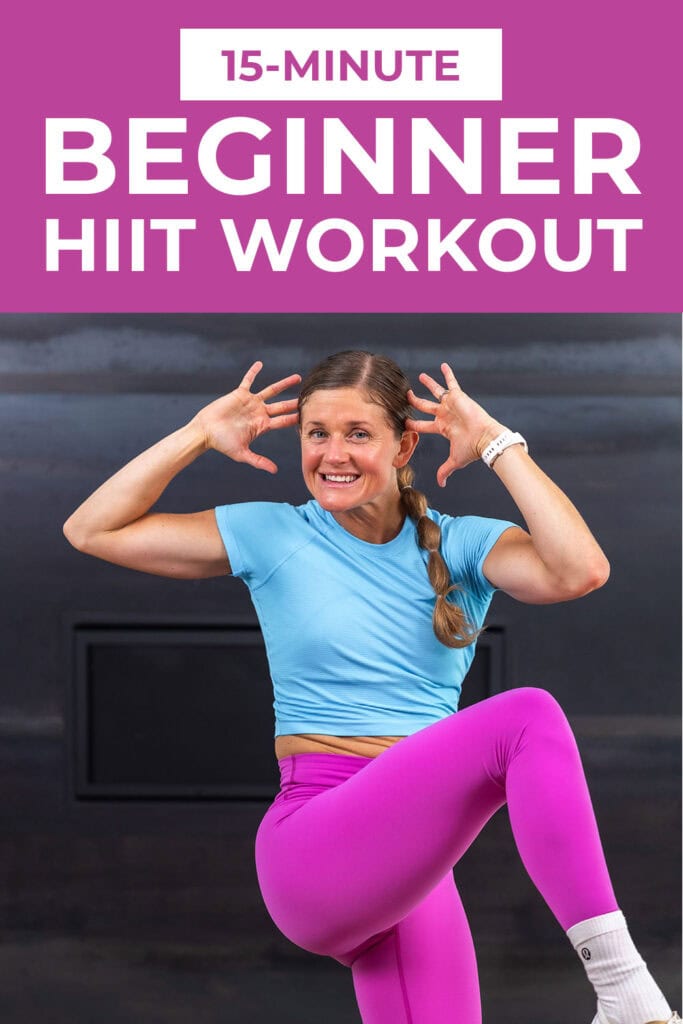
















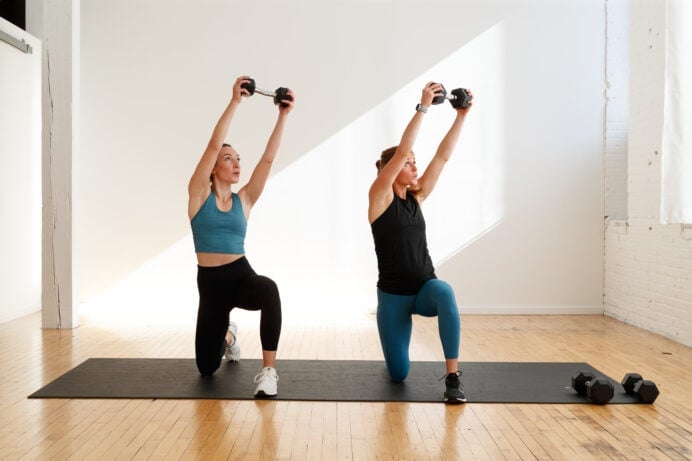


Leave a Comment